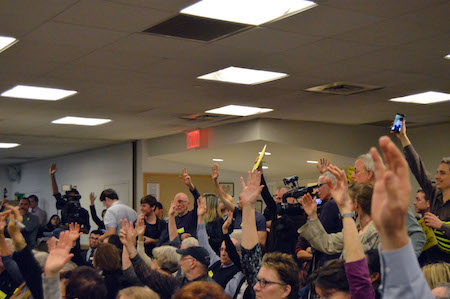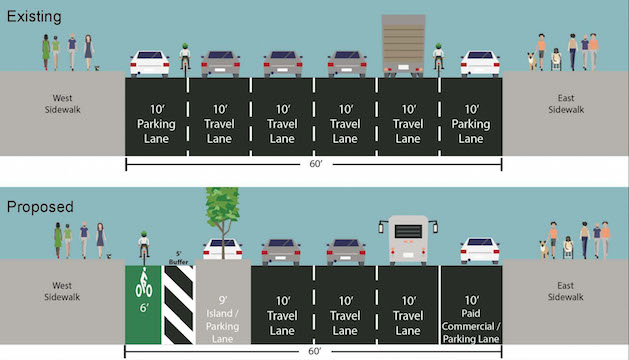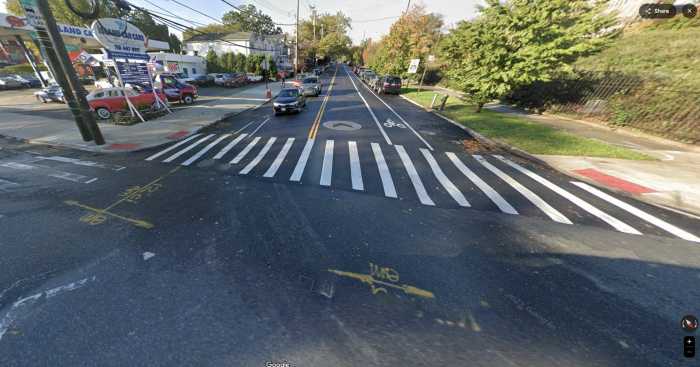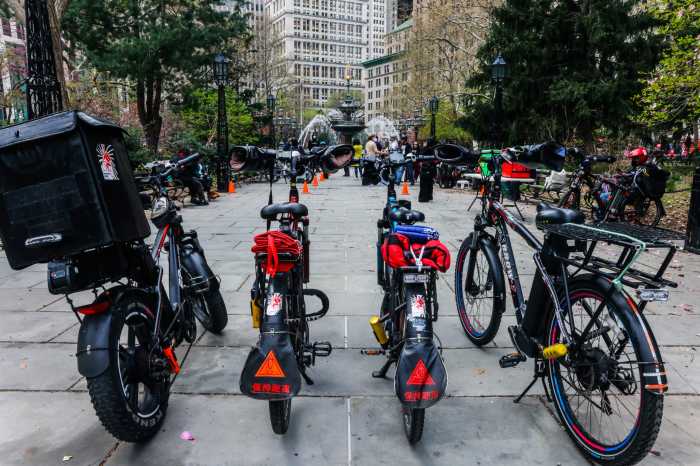
BY JACKSON CHEN | The Department of Transportation’s proposal for an Amsterdam Avenue bike lane won a majority vote in favor from Community Board 7 on February 2.
Ending a more than four-hour discussion with comments from residents on both sides, the board tallied 28 votes in favor to 13 against — with two abstentions –– giving the proposal for a northbound bike lane from 72nd Street to 110th Street a comfortable margin of victory.
The DOT’s redesign of Amsterdam Avenue –– a key feature of which is a protected bike lane –– would reduce the current four auto lanes to three. First introduced in November, the DOT proposal would also introduce shorter crossing distances through pedestrian islands and would limit some stretches of avenue parking during certain hours to make way for truck delivery loading zones.
With the inclusion of a bike lane and left-turn bays for motorists, parking spots would be reduced by 21 percent, which is less than the 25 percent the DOT originally projected.
Backing up the CB7 majority that supported the DOT’s proposal, resident cyclists packed the Goddard Riverside Community Center on Columbus Avenue so much that police had to escort dozens of people out of the hallways due to fire safety concerns.
Despite limiting access to the meeting, the proposal’s remaining supporters shared their testimonies in the form of personal stories and calls for a safer avenue.
“We’ve always known that Amsterdam has been crazy,” said Kathleen McAnulty, a member of Families for Safe Streets and a 35-year resident of the Upper West Side.
For McAnulty, the safety improvements can’t come quickly enough. On January 14, a motorcyclist fatally struck her 73-year-old father on the crosswalk near Amsterdam Avenue and West 96th Street.
“Something has to be done,” McAnulty said, adding she was in disbelief that she was able to share her story just three weeks into her mourning. “If it’s not done, more people are going to die.”
Joining the voices in favor, City Councilmembers Helen Rosenthal and Mark Levine spoke up for the DOT’s proposal.
“The Department of Transportation is responsible for coming up with safe streets,” Rosenthal said. “They’ve done right by us with West End Avenue and they did right by us with Columbus Avenue.”
Rosenthal, who’s been pushing for improving Amsterdam Avenue since her days as the CB7 chair in 2007, said she doesn’t want to receive another phone call or tweet about a crash in her district.
Representing the district just north of Rosenthal’s, Levine shared the same sentiments regarding the safety of the Amsterdam Avenue corridor.
“A street that was designed 50 or 60 years ago needs to be updated,” Levine said. “It was designed in a different era when the concerns for pedestrians and others were not given primary consideration and the result, not surprisingly, has been unacceptably high numbers of injuries and even fatalities.”

To be sure, the crowd didn’t unanimously praise the DOT’s proposal, as some felt the bike lanes would create more congestion, hamper local businesses, and endanger the senior and disabled communities.
Picking on their comments from the January 12 CB7 Transportation Committee meeting that ended in a 4 to 4 vote, committee co-chairs Andrew Albert and Dan Zweig remained staunch in their opposition.
Once again, Zweig asked for a proposal from DOT that would include pedestrian safety improvements for Amsterdam Avenue without incorporating a bike lane. The Transportation Committee co-chair advocated implementing the safety features for pedestrians first and then looking at options for a northbound route for bicyclists.
Opposition took the form of a substitute resolution proposed by board member Sheldon Fine. His proposal urged the DOT to instead consider installing a two-way route on the existing southbound protected bike lane on Columbus Avenue.
But Sean Quinn, the co-director of the DOT’s Pedestrian Projects Group, responded that pedestrian safety treatments without the bike lane on Amsterdam Avenue –– such as installing neck-downs that would shorten pedestrian crossing distances –– wouldn’t be as effective as the planned redesign that includes the bike lane.
The board voted down Fine’s substitute resolution, citing the years of work they put into the original proposal and arguing that a last-minute resolution would be unfair.
Board member Mel Wymore said Fine’s resolution was “sand-bagging a two-year process” and that the bike lanes were part of a larger design that would calm the traffic on Amsterdam Avenue.
Ultimately, the board sided with the DOT’s proposal but requested both data and oversight. Board members said they wanted to see more numbers regarding the impacts on the elderly and disabled communities as well as on the avenue’s family-run businesses.
Having already been part of the creation of a bike lane on Columbus Avenue, CB7 members said they want more involvement this time around, with the DOT continually checking in with the board before, during and, after implementation.
With CB7’s supportive vote, the DOT is expected to begin the Amsterdam Avenue redesign as early as spring.





































